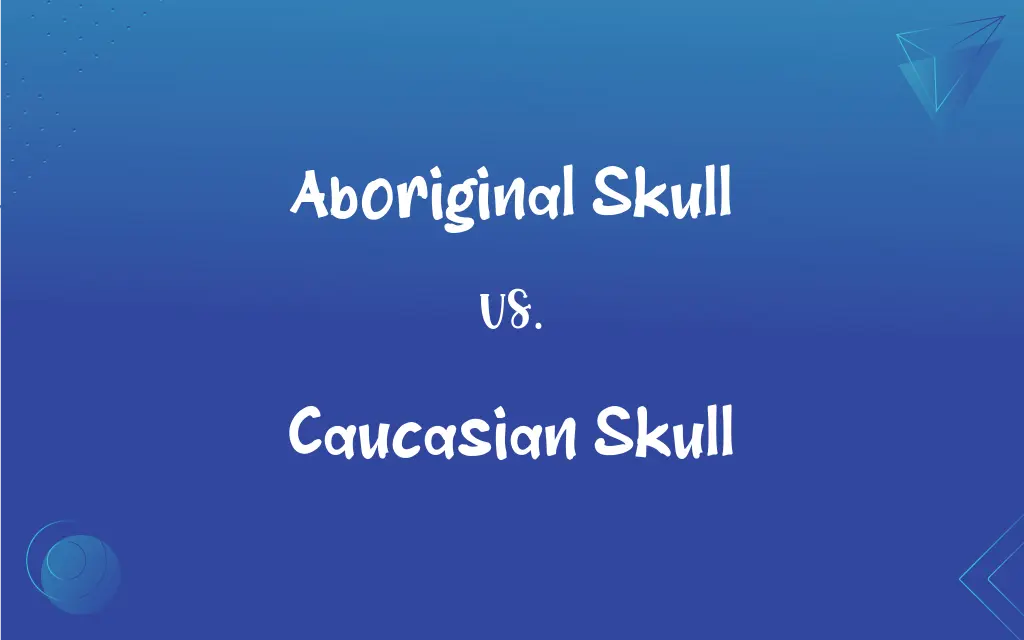Aboriginal Skull vs. Caucasian Skull: What's the Difference?
Edited by Aimie Carlson || By Janet White || Published on February 6, 2024
Aboriginal skulls often have broader facial features and larger nasal cavities compared to Caucasian skulls, which typically exhibit narrower faces and higher, more pronounced nasal bridges.

Key Differences
Aboriginal skulls are generally characterized by a broader facial structure, prominent cheekbones, and larger nasal cavities. This contrasts with Caucasian skulls, which tend to have a more elongated facial structure, with higher cheekbones and a more pronounced nasal bridge. These differences reflect adaptations to diverse environmental and genetic factors.
In terms of cranial shape, Aboriginal skulls usually have a more rounded appearance, with a wider cranial base. In comparison, Caucasian skulls often display a longer, narrower cranial shape. These variations in cranial shape are part of the complex tapestry of human biodiversity.
The eye orbits of Aboriginal skulls are typically more rounded, while those in Caucasian skulls are often more angular. This difference in orbital shape is one of many distinct physical characteristics that distinguish these groups.
Aboriginal skulls might exhibit a more pronounced brow ridge compared to Caucasian skulls, where the brow ridge is typically less prominent. This feature contributes to the distinct facial profiles observed in these populations.
The dental structure also shows variations, with Aboriginal skulls often having larger, more robust teeth, while Caucasian skulls generally have smaller, finer teeth. This difference reflects dietary adaptations and genetic heritage.
ADVERTISEMENT
Comparison Chart
Facial Width
Broader
Narrower
Nasal Structure
Larger cavities
Higher, more pronounced bridge
Cranial Shape
Rounded, wider base
Longer, narrower
Eye Orbits
Rounded
Angular
Brow Ridge
More pronounced
Less prominent
ADVERTISEMENT
Dental Structure
Larger, robust teeth
Smaller, finer teeth
Aboriginal Skull and Caucasian Skull Definitions
Aboriginal Skull
A representation in physical anthropology of indigenous cranial features.
The Aboriginal skull showed distinct features different from other ethnic groups.
Caucasian Skull
A physical anthropology tool for understanding genetic and evolutionary history.
The Caucasian skull in the museum displayed traits common to its ethnic group.
Aboriginal Skull
A skull originating from indigenous populations of a region.
The museum displayed an Aboriginal skull, providing insight into the region's ancient inhabitants.
Caucasian Skull
An anatomical reference in studies of human skeletal structure.
In the anatomy class, the Caucasian skull helped illustrate variations in human skull shapes.
Aboriginal Skull
A symbol in anthropology for studying human variation and adaptation.
The Aboriginal skull in the lecture illustrated the diversity of human cranial forms.
Caucasian Skull
An educational specimen in comparative anatomy.
Students compared the Caucasian skull to others to understand cranial diversity.
Aboriginal Skull
An anatomical specimen representing the cranial characteristics of Aboriginal peoples.
Researchers studied the Aboriginal skull to understand early human migration patterns.
Caucasian Skull
A symbol in forensic science for identifying racial characteristics in skeletal remains.
Forensic experts used the Caucasian skull to demonstrate techniques in racial identification.
Aboriginal Skull
An archeological artifact significant in understanding prehistoric human societies.
The excavation unearthed an Aboriginal skull, shedding light on ancient lifestyles.
Caucasian Skull
A skull typically associated with populations of European descent.
The Caucasian skull was used in the study to compare cranial differences among ethnicities.
FAQs
Is there a difference in the brow ridge between Aboriginal and Caucasian skulls?
Yes, Aboriginal skulls often have a more pronounced brow ridge compared to the less prominent one in Caucasian skulls.
How does a Caucasian skull differ from an Aboriginal skull?
Caucasian skulls often have narrower faces, higher cheekbones, and a more pronounced nasal bridge.
What does the Aboriginal skull represent in anthropology?
It represents a key specimen for studying human variation, adaptation, and prehistoric societies.
Can the shape of the skull determine the race of an individual?
While certain traits are indicative of racial groups, there is considerable overlap and variability.
What are the main features of an Aboriginal skull?
Aboriginal skulls typically have broader faces, prominent cheekbones, and larger nasal cavities.
Are the cranial shapes different in Aboriginal and Caucasian skulls?
Yes, Aboriginal skulls tend to be more rounded with a wider base, while Caucasian skulls are usually longer and narrower.
Is there a cultural significance to these skull types?
Yes, they are often studied to understand the cultural and environmental adaptations of different human groups.
How are these skull types used in comparative anatomy?
They are compared to understand the diversity and commonalities in human cranial structure.
What about the eye orbits in Aboriginal and Caucasian skulls?
Aboriginal skulls generally have rounder eye orbits, while Caucasian skulls have more angular orbits.
What significance does the Caucasian skull have in physical anthropology?
It's important for understanding genetic history and variations in human skull shapes.
Do these skull differences impact brain size or intelligence?
No, skull shape does not correlate with brain size or intelligence.
Can these skull types change over time?
Yes, evolutionary and environmental changes can influence skull shape over generations.
How do the teeth in Aboriginal skulls compare to those in Caucasian skulls?
Aboriginal skulls usually have larger, more robust teeth, whereas Caucasian skulls have smaller, finer teeth.
Can the study of these skulls reveal information about ancient diets?
Yes, dental and skull structure can provide clues about historical dietary patterns.
Are there ethical considerations in studying human skulls?
Yes, respect for indigenous cultures and proper handling of human remains are crucial.
Are there genetic studies linked to these skull types?
Yes, genetic studies help in understanding the hereditary aspects of cranial features.
Are these skull types used in forensic science?
Yes, both are used for identifying racial characteristics in skeletal remains.
How accurate are reconstructions based on these skull types?
Reconstructions can be quite accurate, but they often require additional contextual information.
Are these skull types relevant in the study of human evolution?
Yes, they provide insights into the evolutionary history and diversity of humans.
Do environmental factors influence the development of these skull types?
Yes, environmental factors play a significant role in shaping physical characteristics.
About Author
Written by
Janet WhiteJanet White has been an esteemed writer and blogger for Difference Wiki. Holding a Master's degree in Science and Medical Journalism from the prestigious Boston University, she has consistently demonstrated her expertise and passion for her field. When she's not immersed in her work, Janet relishes her time exercising, delving into a good book, and cherishing moments with friends and family.
Edited by
Aimie CarlsonAimie Carlson, holding a master's degree in English literature, is a fervent English language enthusiast. She lends her writing talents to Difference Wiki, a prominent website that specializes in comparisons, offering readers insightful analyses that both captivate and inform.






































































